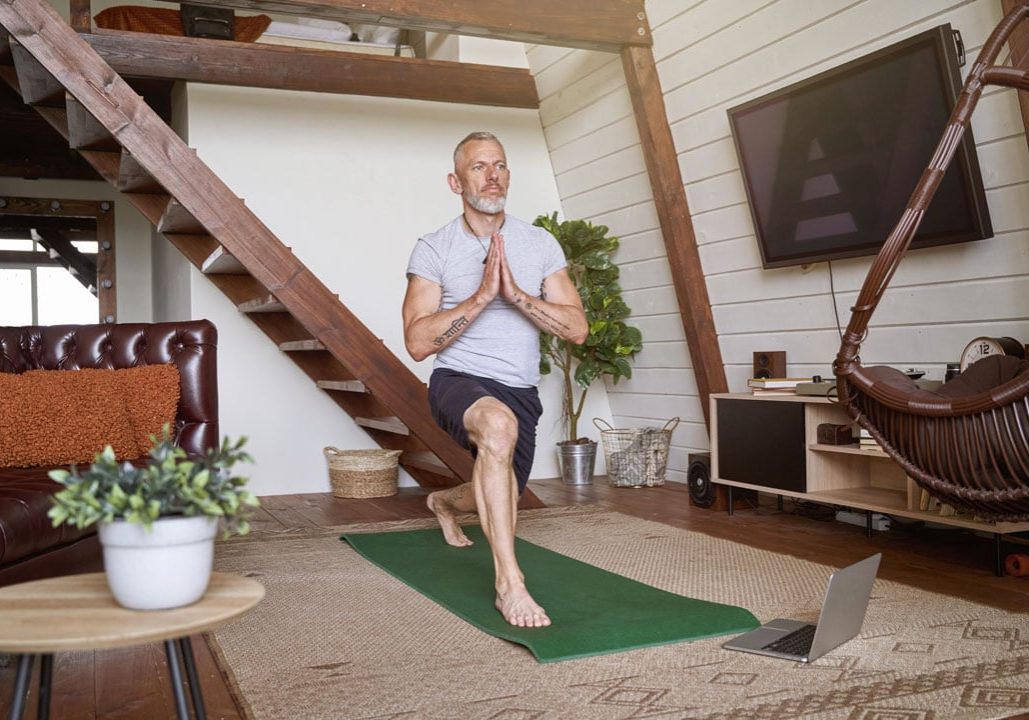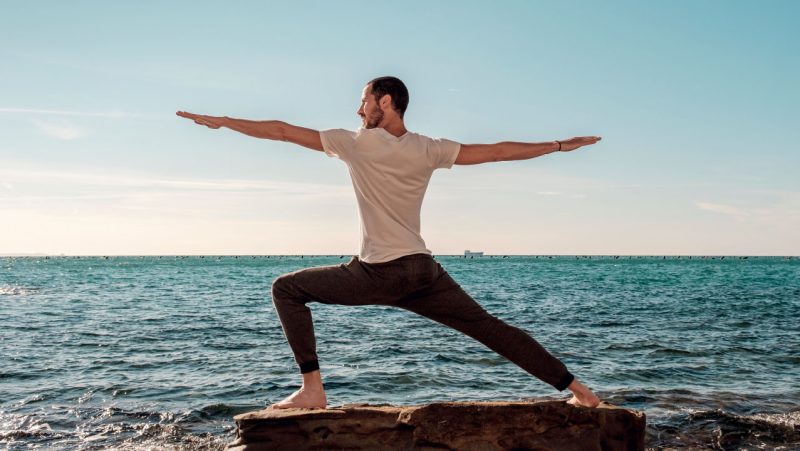
Yoga for calm endurance - Titiksha
Developing Titiksha, a yoga for calm endurance, during difficult times. By Jenny Light
Faced every day with social distancing and the isolation which comes from that, yoga has become, for many of us, our personal refuge from the Covid era.
From yoga, we learn Titiksha, a Sanskrit term meaning: patient endurance as a practical approach to ride out the storm of suffering. While in our lucid moments, logic tells us that this pandemic situation will not last forever (and that we can get on with living our lives), locked within our own four walls with minimal face-to-face interaction, as social animals, this can be very tough.
Titiksha teaches us that what we are perceiving in this moment will change. You need only put one foot in front of the other, one breath after the other, and you will come out of the tunnel at the other end. Nothing lasts forever, as everything in this transient world is subject to change. It is a heartening assurance that when the pendulum of life swings to the extremes, it will eventually return to an equilibrium and, while it can be quite unsettling in the midst of an extreme shift or change, that we have been through difficult periods in the past and we will get through this.
Yoga lifeline
Yoga then becomes a lifeline, a buoy to save us from drowning in social isolation. Here, then, are a few of the ways in which you might use asana, pranayama and meditation to practice patient endurance.
First of all, earmark 30 minutes in your day to have no communications, no intrusions. In a lifestyle of virtual communications, it is important to have no interruptions in order to give your full undivided attention to your yoga practice. Research has shown that subjects were much more distracted when their phone is present in the room. So switch off notifications and mute your phone. Or even put your phone out of the room.
Start with an affirmation to set the intention of your practice. Sitting upright in Sukasana (crossed legs), bring palms to namaste (praying hands) at the heart centre. Gently close the eyes. Breathe in deeply and sigh out three times. Draw your attention and will to the brow centre and affirm: “I am calm. I will patiently endure all (of life’s) changes with strength and calmness.”
Yoga practices were designed to discharge physical, emotional and mental restlessness or ‘static’, lubricating our physical and energetic systems with oxygen and prana (life force energy) to be better disposed to sit quietly for a restorative meditation. If we do not have mental and physical calmness at the beginning of a yoga practice, it quickly reinstates and rights us to calm within a few asanas. Calmness is the ultimate result of yoga.
Patience is required to allow your practice to work its magic over a few weeks and months, and to certain extent within the 30 minutes assigned to your individual daily practice. It doesn’t really matter which asanas you choose. Physical movement that is partnered with concentrated attention in tandem with a synchronised breath, will be enough to change your state of being. Although, do try to have mixture of standing, kneeling, inverted postures, twists, balances and prone postures to have a balanced practice over a period of a week.
The ratio of asana: pranayama: meditation over a 30-minute practice is more important. If you have an untutored busy mind then the ratio would be 20: 5: 5 (i.e: 20 minutes physical asana, followed by 5 minutes breath practice and 5 minutes of meditation). Those with a restless butterfly mind will benefit from a physically vigorous asana practice, such as Surya Namaskar (sun sequence). But if you have already some experience with bringing the mind and body to calm through daily practice, then the ratio might be 10:10:10.
Focused attention
The most important factor to apply to any ratio is attention. The attention must be in the asana, present in the observation of the breath and alert and awake in the meditation, irrespective of whether these are long or short timescales.
Just be in your asana practice, trusting that while you are engrossing your concentration in the movement, the practice is working its magic: stripping the body and mind of restless static, replacing it with a prana-becalmed exhilaration, which further invites your attention to show up in the present moment.
Five or 10 minutes of Nadi Shodhanam (alternate nostril breath) will clear wisps of residual static and charge the cells of the body with revitalising life force. Nadis are the energy pathways of the energetic (astral body), which like the nerves of the physical body leading back to the physical spine and brain, the 72,000 nadis of the energetic body criss-cross the string of chakras on the astral spine leading to Sahasrara (the astral brain). Shodhanam means cleansing. It’s a bit of a miracle how five or 10 minutes of Nadi Shodhanam breath practice — breathing in through one nostril and out through the other — has such a profound effect on anxiety and mental restlessness in a short space of time.
Last of all in your daily practice comes meditation: the pinnacle of your practice. Those who are new to meditation often find that they are besieged with a restless mind and even assume that meditation makes the mind more restless!
The truth is that the restless mind is no more restless than it was, but when the eyes are closed and the attention is temporarily divested of the entertainments of the external world, it can seem to be more restless. Even if you do not think that you could close your eyes and give full attention within, attempting meditation after asana and pranayama, it is remarkable what you can achieve.
Take the analogy of a glass of muddy water: if you allow the water to become still, the sediment settles to the bottom of the glass. But if you mentally stir up the contents with restless thoughts, the water remains muddy. Imagine that you are watching the mental silt settle to the bottom of the glass. Just observe the thoughts: if you don’t engage with them, they just sink to the bottom. Use each breath to mentally ‘ride the inhale’ and ‘ride the exhale’ without disturbing the water in the glass. This is Titiksha (calm endurance).
Titiksha strength
In the inevitable times in life when we are struggling with trials, Titiksha lends us great strength. When I was child, I was beset with asthma. This was in the sixties before doctors took asthma seriously. Without medication, I was bed-bound sometimes for a week at a time. Just getting the next breath in became my focus. I had to learn calm endurance. There was no room for alarm or anxiety which would only exacerbate the lack of breath. I used a mental affirmation in each breath: ’This too shall pass’. Experience told me that I just needed to ride this episode and it would pass. I found a great mental strength in this which in later life I applied in childbirth, overcoming chronic fatigue syndrome, or any trial that came along: this too shall pass.
I think that each one of us will have already endured pain, loss and extreme periods of difficulty and travelled through many tunnels into the sunlight at the end. It’s just that while we are in a tunnel, this can seem overwhelmingly difficult, but we can’t let the monkey mind run away on thoughts of negativity or alarm. Just keep calmly breathing and say aloud or mentally: this too shall pass.
Yoga helps us to develop that strength of will to apply patience to determinedly plod one foot in front of the other towards the light at the end of the tunnel, even when that end isn’t in sight. Cling steadfastly to the raft of your daily practice for with it comes a strength: “I may not be able to do much about what is happening but I can do this.”
Just 30 wonderful, transformational minutes a day is all it takes to lift the mind, hone the body and prepare the consciousness to inner calm.
Practice #1: Meditation using a hand mudra
The following meditation is particularly balancing and grounding if you are mentally all over the place. It uses an easy hand gesture (mudra) to access the stabilising energies of the earth element associated with the base chakra.
Sit upright. Encircle the ring finger of you left hand with the fingers of your right hand with the right thumb resting in the left palm.
Visualise that you are standing in a field of golden grasses, waving in the breeze. Feel the solid earth beneath your feet and the wind in your hair, lifting away all restless thoughts.
As you breathe in, the golden grasses sway toward you.
As you breathe out, the grasses wave away from you in all directions.
Become the epicentre of the field of grass, moving toward you as you breathe in and rippling away from you are you breathe out.
(Repeat the mudra and visualisation with the other hand).
Practice #2: Nadi Shodhanam (alternate nostril breathing)
Place the right thumb just beneath the right side of the bridge of the nose, little finger and ring finger rests lightly just beneath the left side of the bridge of the nose (nasagra mudra). (The index finger and middle finger rest lightly on the brow or alternatively, tuck the index finger and middle finger into the palm to alleviate pressure on the brow centre).
Close the eyes. Through the touch of the fingers, become aware of the resonance and rhythm of the breath through the bridge of the nose.
Close the right nostril and breathe in through the left nostril. Hold the breath and the attention briefly on the brow. Close the left nostril and breathe out through the right nostril. Breathe in through the right nostril. Hold the breath on the brow. Close the right nostril and breathe out through the left nostril. This constitutes one round.
Repeat for 12 rounds. Aim for an equal inhale and exhale: long and smooth.
N.B. Contraindications for alternate nostril breath are those with breathing disorders such as asthma and those with high blood pressure, nasal obstructions or heart issues who should not retain the breath after the inhale but just stick with an easily manageable inhale and exhale. If for any reason holding the hand position or restricting air flow is not comfortable, then just visualise breathing in through one nostril and out through the other alternately.







